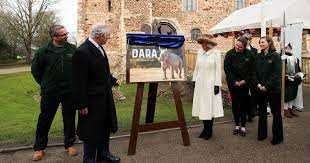
King Charles III and Camilla the Queen Consort have visited Colchester to deliver an official document referred to as a “Letters Patent” which formally awards city status upon the historic Essex location.
As part of Queen Elizabeth II’s Platinum Jubilee celebrations last year, around 40 sites around the United Kingdom bid to have the civic honour granted to them and an independent panel chose their winning eight, and with due respect to the other seven, Colchester has a very worthy claim to be the most deserving of them all.
That is because it is Britain’s oldest recorded settlement and as such, it is widely regarded as the country’s very first capital city. It was a hub of Roman culture, a thriving result of a planned colony, built to receive merchants and traders and very much the heart of the Roman machine on British soil.
Once the Romans were moved out after an uprising, the title was lost and it has taken almost 2,000 years to regain its status back again. In this regard, the place is steeped in history and when considering some of the towns around the country that had already gained city recognition, it seemed almost inconceivable that Colchester was overlooked for the distinction.
Applicants had to demonstrate what made them deserving of the award with regards to local identity and uniqueness. If that criteria were analysed against a great many existing cities, they would trail a long way behind Colchester. They also were asked to highlight royal associations and cultural heritage and once again the place scores massively, on both counts.
The royal couple spent two hours being taken around the city meeting dignitaries and charity representatives, volunteers and school children; as well as soldiers from the military garrison, of which there has been a base since the Roman era and their conquest of Britain in AD43.
Granting of city status a Jubilee practice
There was no shortage of bids for the honour of being one of the eight Platinum Jubilee cities with as many as 40 staking their claim. It has become something of a tradition to mark a Jubilee year with such an act, with among others, Derby gaining the award for the Silver; Sunderland for the Ruby; Newport and Preston for the Golden; and Chelmsford, Perth and St Asaph being chosen in 2012 for the Diamond.
Although it is simply a status appointment with no attached privileges, there is evidence that it can boost local economies, with Perth seeing an expansion of something in the region of 12%, after their award a decade ago.
The lucky eight
The eight who were successful this time around were split across all four nations of the United Kingdom: Colchester, Doncaster, and Milton Keynes in England; Bangor in Northern Ireland; Dunfermline in Scotland; Wrexham in Wales; Douglas on the Isle of Man; and Stanley on the Falkland Islands.
Colchester receives the Letters Patent
To make the awards official, each city needs to receive a “Letters Patent”, and upon the King’s visit, Colchester became the seventh of the eight to receive the formal seal of approval, with just Douglas on the Isle of Man now outstanding.
With the addition of these eight the total number of cities now in the UK has risen to 76, with 55 in England, eight in Scotland, seven in Wales and six in Northern Ireland.
Proud moment for people of the city of Colchester
King Charles III’s visit to Colchester took in the new city’s castle and library, in what those who campaigned for the status to be granted said: “would be one of the highlights of a whole year of celebrations planned to mark the significant change.”
Darius Laws who is the Conservative Group leader called it a “monumental day and an absolutely historic moment for this amazing place we call our home.” He continued to declare that he told the royal couple that it felt like they were bestowing a knighthood upon his town/city. He added: “They were lovely and clearly enjoyed getting to know Colchester and the people.”
The High Steward of the new city, Sir Bob Russell, was even more generous in his praise of the King and Queen Consort, saying: “This will go down as one of the greatest days in Colchester’s evolving history; it is the first time a Mayor of Colchester has welcomed a King, and I am so proud.”
Relaxed atmosphere makes for a fabulous visit
The royals were made to feel very welcome by an enthusiastic gathering at the city library. Camilla was greeted at the “Literary Corner” by actors from a local theatre group who were dressed up in Alice in Wonderland costumes, demonstrating how the facility often organises readings to bring popular children’s books to “life”.
Charles and Camilla also wandered around the grounds of the 11th century castle, speaking with flag waving schoolchildren and also chatted with soldiers and dignitaries in a really pleasant setting and relaxed atmosphere.
Before departing Colchester they paid a visit to the large zoo and were invited to reveal the name of its newest addition, a baby white rhino that has been called Dara.
“Confirmation” of city heritage
The town crier Bob Needham, 81, summed up the feeling of the place when he said: “I think city status is a fantastic thing for Colchester as it determines us as what we are, the first city in this country. It is confirming that for all to know.”
Roman city defeated in uprising
Colchester is indeed widely regarded as Roman Britain’s first major city, as well as its original capital. Known then as Camulodunum, its fortress was turned into a civilian settlement named “Colonia Claudia” after the Roman Emperor of the time.
An uprising against the Romans by the Iceni tribal Queen Boudicca in AD60, brought an abrupt and violent end to the prosperity of the bustling heartland of the Roman rule in the city. In actual fact it was completely destroyed by the rebelling Brits, with mass slaughter and was reduced to rubble and with it the city status was gone.
The Romans found another British focal point further south and easier to reach by freight ships and that of course was… London.
Walks around the Roman walls still a visitor attraction
The Roman walls are thought to have been constructed between 65AD and 80AD, and two large stretches of it are still standing on the west and north sides of the city. An impressive survivor is the Balkerne Gate which is accepted as the earliest and most complete Roman gateway in the UK. It is possible to take a near circular walk of almost 2 miles (3 km), which follows its course and other surviving sections.
Still the cultural capital of the county
The historic – now – city, has a population of around 120,000, and its Garrison is home to the UK’s Rapid Response Force, the 16th Air Assault Brigade. It lies 50 miles (80 km) north-east of London and is around 30 miles (50 km) from London Stanstead Airport.
Controversially in 2012, neighbouring Chelmsford was bestowed city status as part of Queen Elizabeth II’s Diamond Jubilee celebrations. This very possibly acted as the stimulation for a push towards equal recognition; although there is little doubt that with its relics from Roman and Norman occupation, plus evidence from the medieval age and a Civil War siege, Colchester is unquestionably the “cultural capital of Essex”.
Historic value to the country immense
No longer is city status reliant upon its size, or indeed the presence of a cathedral, or university. It is basically all down to the presentation of a bid and its ability to meet set criteria, which needs to demonstrate the location has its own identity, plenty of heritage, and royal association.
It was during the reign of Henry VIII in the 16th century that the tradition of needing a cathedral to be allowed city status began and continued through several centuries, which is why in a very large percentage of the British cities one does indeed exist.
Present day the prerequisite is more in keeping with the significance a place has to the country, and with that in mind, Colchester should really have been made a city a long time ago.













0 Comments